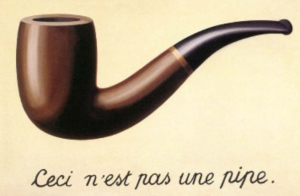It seems odd that in our many discussions regarding John Berger’s art criticisms in Ways of Seeing, we never discussed the most immediate visual in the book: the cover. It is a painting by the Belgian artist René Magritte, and the fact that Berger chooses a work by Magritte is rather unexpected — given the philosophical beliefs of the artist.
The oil painting The Treachery of Images is arguably Magritte’s most well known painting. The visual depicts a realistic pipe accompanied by the words “Ceci n’est pas une pipe” (This is not a pipe). While the painting and the subtitle initially seem to be contradictory, it slowly becomes apparent that it is not: Magritte has created an image of a pipe, and not a physical pipe itself. The relation between visual and text of The Treachery of Images expresses Magritte’s belief that even the most realistic of images would never be able to accurately capture an object.
Berger claims in Ways of Seeing that “what distinguishes oil painting from any other form of painting is its special ability to render tangibility …[and] although its painted images are two-dimensional … [its realism can fill] a space and, by implication, fill the entire world” (89). This claim that oil painting is a medium that allows for close representation of reality is one Magritte would agree with. However, the claim that it can “fill the entire world” with suggestions of physical objects would not be taken well by the Belgian painter (89). In this specific instance, Berger argues that oil painting is a depiction of objects which is realistic to a point of great symbolic value, while the man who created the image on the cover believes that there will always be a significant gap between an image and the object it depicts.

